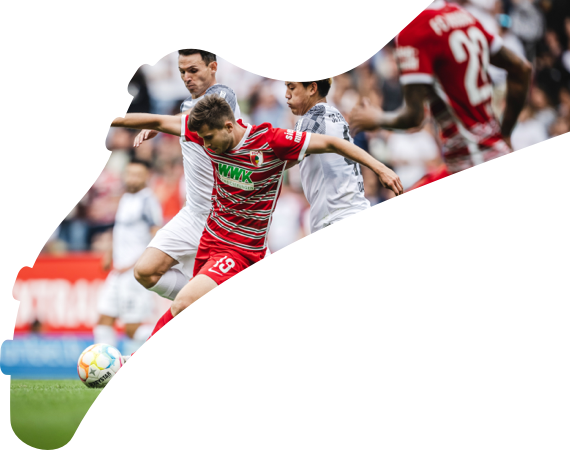
Kovac, Nagelsmann, Favre, Rangnick: the 2018/19 Bundesliga tactical review
The Bundesliga is known for its tactical astuteness, combining rigid German efficiency in defence with free-flowing attacking play to create some of the most eye-catching matches in world football. It’s all thanks to a young crop of coaches like Niko Kovac, Julian Nagelsmann, and Florian Kohfeldt, but it doesn’t mean there isn’t room for some experienced grey hairs from Lucien Favre and Ralf Rangnick.
They were just five of the 25 tacticians to take charge of the 306 Bundesliga matches in the 2018/19 season, during which time there were 25 different starting formations used. These either employed a four-man defensive line or a back three (there were two back fives officially recorded, but these are seen as more defensive three-man backlines) behind numerous combinations of midfielders and attackers.
bundesliga.com takes a closer look at the preferred formations of 2018/19, which were the most successful, which were the ones to avoid, whether a three- or four-man defence is the way to go and how many forwards you need in your team.
The return of 4-4-2?
Previously seen as the outdated approach of teams from England, the 4-4-2 formation was used in 28 per cent of Bundesliga line-ups in 2018/19, compared to 18 per cent the previous season. It was most frequently seen with Mainz (25 games), Freiburg (24) and RB Leipzig (23), showing that it is suitable both for clubs across the table and with different approaches to the game.
Teams beginning with a 4-4-2 emerged victorious in 45 per cent of matches, which narrowly trails those using a 4-3-3 (47 per cent) and 4-2-3-1 (46 per cent). It’s worth noting, however, that those were the preferred formations of Kovac’s title-winning Bayern Munich side and Favre’s runners-up Borussia Dortmund respectively.
Removing those two teams from the statistics for these formations throws up some perhaps surprising results. Take them out of the 4-3-3 category and the win rate for the remainder of the league drops to 42 per cent, while the Bundesliga’s other 16 clubs only won 38 per cent of matches when they used a 4-2-3-1 – a drop of over eight per cent. This is also despite a substantial drop in the use of 4-2-3-1 throughout the league (20 per cent in 2017/18; 15 per cent in 2018/19), while 4-3-3 has risen from 18 per cent up to 21 per cent.
Watch: Dortmund’s tactics under Favre

Leaving the three behind us?
It was the tactical approach of choice for Nagelsmann’s Hoffenheim, Adi Hütter’s European crowd-pleasers Eintracht Frankfurt and Schalke under Domenico Tedesco and Huub Stevens, but a three-man defence was also a feature of every club’s formation except Bayern, Dortmund and Wolfsburg, who never used it in 2018/19. Nevertheless, its use is well down on the previous season.
In 2017/18, 35 per cent of Bundesliga line-ups started with a back three compared to just 28 per cent in the campaign just gone. Not only was it used less, the three-man defence was also less successful. Last season its greatest proponents (Schalke and Hoffenheim) finished second and third in the table, contributing to an overall 31 per cent win rate. Fast forward to 2018/19 and that rate dropped to 24 per cent, as did the final positions of those two teams mentioned (14th and ninth).
Accordingly, the success rate of a back four rose from 40 per cent to 43 per cent, yet this does not entirely discredit a three-man backline. Frankfurt used it more than any other team in the Bundesliga (in 30 of 34 games) and they only missed out on UEFA Champions League qualification on the final day, as well as reaching the semi-finals of the UEFA Europa League. The Eagles boasted the fifth-best defence in the league and won just one of their four games when not using three at the back. As Nagelsmann and Tedesco did the previous year, Hütter proved the approach can work with the right players and tactics.
Leipzig also went through a period of using three at the back during the second half of the season – perhaps seen as preparation for the arrival of Nagelsmann for 2019/20 – and were very successful in their attempt. Rangnick’s side remained unbeaten in their nine matches using a back three, winning six of them.
How many men up top?
You’ve settled on your defence so how do you go about the business at the other end of the pitch? With 4-4-2 being the most popular formation of the campaign, it’s little surprise that teams lining up with two strikers is the most common approach (47 per cent). A lone striker was used on 27 per cent of occasions, while a front three was seen in 26 per cent of matches.
While win percentages were close between 4-4-2, 4-2-3-1 and 4-3-3, there is more of a spread when looking at just the attacking line-up. Using a front three produced the greater proportion of victories (41 per cent), just ahead of a solitary front man (40 per cent), but results drop off with two strikers, seeing a win rate of just 35 per cent.
However, as mentioned earlier, a sole striker and a front three were the overwhelming favourite approaches for Dortmund and Bayern respectively. Remove their results from the above win rates and there is a substantial change. The success rate for one striker drops by 10 percentage points to 30, while the trio comes down by seven to 34.
Watch: How Bayern pick apart defences

Versatility or consistency?
Do you want to be able to surprise the opposition with your versatile team selections or have a team very well drilled in a small number of systems? The stats would appear to suggest the latter. Two of the four teams to use the most formations were relegated in 2018/19 (Hannover and VfB Stuttgart), while Augsburg were the lowest placed club to survive.
This is perhaps the result of desperation to find a winning formula and the change of coaches that took place over the course of the season (Stuttgart even had three), yet bottom side Nuremberg showed themselves the exception that proves the rule – only five teams used fewer formations than Der Club.
At the other end of the table, four clubs showed that consistency and clarity reign supreme. Dortmund, Leipzig, Borussia Mönchengladbach and Wolfsburg all qualified for Europe and used just four different formations, with some of those simply being variations on another (e.g. Leipzig’s 4-4-2 diamond and their 4-4-2 with a flat midfield). Champions Bayern only used five (including two variations of 4-3-3) and Champions League qualifiers Bayer Leverkusen employed just six under Heiko Herrlich and Peter Bosz.
Ones to avoid
To have a chance of winning a Bundesliga match, it appears you should not start with an outright five-man defence. It differs from a back three in the use of traditional full-backs alongside three centre-backs instead of more attacking wing-backs but failed to earn even a point in two appearances for Nuremberg and Augsburg.
Watch: How did Tifo Football do predicting the top six’s tactics?

A 3-4-2-1 line-up was seen three times in 2018/19 with Frankfurt, Hannover and Hoffenheim, but only the latter claimed any points. A variation of a 3-4-3 was used on 30 occasions with just five victories (17 per cent) and 15 defeats (50 per cent - the most of any formation used more than four times).
What’s to come in 2019/20?
Tactical eyes will be trained on the Red Bull Arena in the coming season as Nagelsmann takes over the helm at Leipzig. The youngest head coach in Bundesliga history is renowned for his innovations on and off the pitch, as well as showing a preference for three at the back. Die Roten Bullen have shown already they are comfortable with that so watch this space.
During his time with Frankfurt, Kovac showed that he was also a fan of a back three but adapted to the Bayern way during his maiden, double-winning campaign in Munich. He will, however, have two new quality defenders at his disposal with Benjamin Pavard and Lucas Hernandez, meaning he has greater reinforcements at the back to feature alongside first-choice centre-back Niklas Süle.
And what changes will be made in Dortmund after BVB’s early shopping spree saw the signings of Thorgan Hazard, Julian Brandt and Nico Schulz? The 2018/19 runners-up are out to go one better with their new faces, and perhaps it will see a new shape. It promises to be a fascinating season yet again come 16 August.
Related news

5 reasons Leverkusen will beat West Ham - AGAIN!
The freshly minted Bundesliga champions have a job to finish after winning the first leg of their Europa League quarter-final tie...

How Wirtz is reinventing the No.10
A key member of Leverkusen's invincibles, we shine the light on how the Germany international has helped Xabi Alonso's men become table toppers.

5 reasons Bayern will go through against Arsenal
After the first leg finished 2-2, Bayern have every reason to believe they can see off Arsenal at home in the UEFA Champions League quarter-finals.


